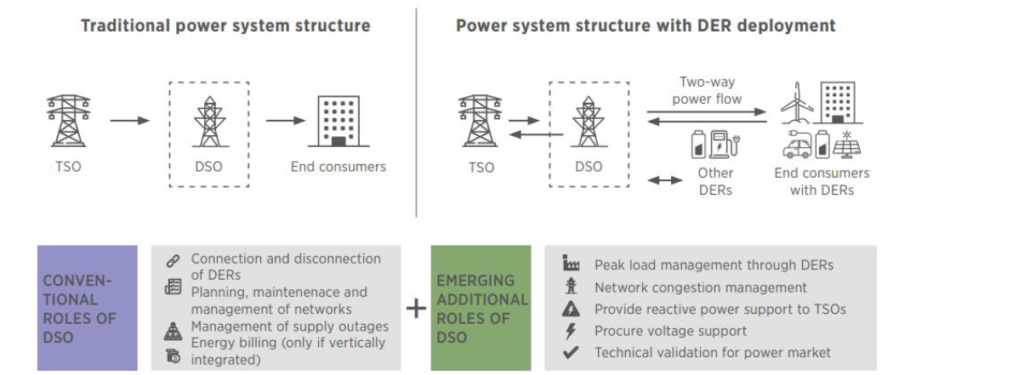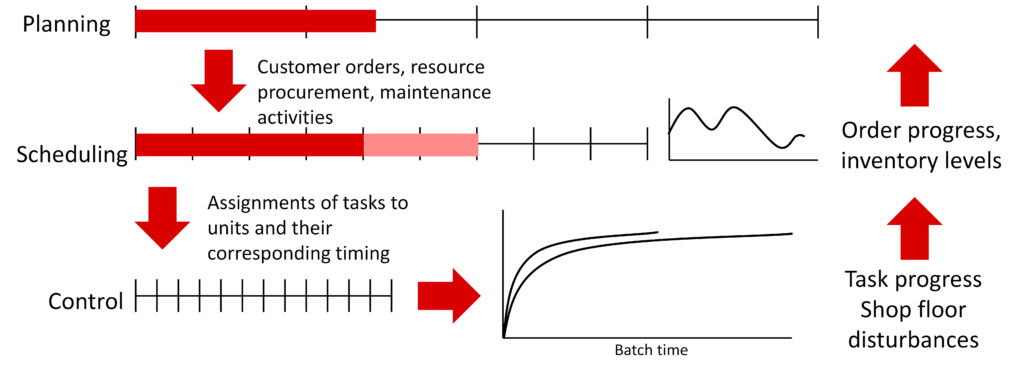Our research team investigates many different aspects of energy systems and process systems engineering. Using tools including simulation/mathematical modelling, optimization, techno-economic and sustainability analysis, data analysis, and machine learning we look mainly into the following areas:
Integrated Energy Systems
Energy is a key driver of the modern economy and its use in society is continually growing due to population growth and increased standards of living, especially in developing countries. The International Energy Agency estimated that total primary energy demand will increase by approximately 40% from a 2016 baseline by 2040 based on current global policies. In this same period, annual CO2 emissions under current global policies will increase by about a third. In order to meet the COP21 Paris agreement targets and to limit global warming to 1.5C emissions during this period need to decrease by 43% [1]. The energy supply sector, consisting of all systems which are related to production, conversion, delivery, and usage of energy, is the single largest source of global CO2 emissions, responsible for 35% of all emissions globally in 2018. Furthermore, the sector has also been the largest contributor to emissions growth since 2010 [2]. Decarbonizing energy systems and transitioning to a sustainable energy future is therefore paramount to the success of a sustainable, carbon-neutral future. This is further complicated by the fact that energy pathways are becoming more complex and highly-integrated (Figure 1). An interdisciplinary approach such as the one employed by our group is needed to address the challenges of modern energy systems.

.
Figure 1: The future of highly-integrated multi-energy systems. Note this diagram is not comprehensive but rather representative of what the future energy system will look like
A core activity of chemical and biochemical engineering is the conversion of resources to products through process synthesis, analysis, and operation. The objective is to determine optimal values for design and operation of the units present in the process flowsheet subject to specifications and performance criteria to produce the desired products. These processes are strongly tied to energy as they are often used to produce energy, or they can be large consumers of energy. Processes that produce energy or energetic fuels for purposes including heat, electricity generation, and liquid fuels, are often based on fossil fuels which are associated with high levels of CO2 emissions. This motivates the need for alternative, ideally carbon-neutral fuels. There are several key classes of alternate fuel production pathways: thermochemical, biological, and electrochemical. Each of these production methods have their strengths and weaknesses and could benefit from process systems engineering techniques including process intensification and polygeneration-based plant design. It is unclear which technologies are most suitable under different economical, environmental, and technological scenarios. For example, with the increased penetration of intermittent renewable power, electricity prices and generation methods are becoming more dynamic in nature. When renewable energy is plentiful, prices are lower and electricity-based fuel production methods, such as electrolysis-based hydrogen production become more attractive. Simulation, optimization, and techno-economic and sustainability analysis of these different aspects of energy systems are of interest to my group.
Power Systems Engineering
The increased presence of variable renewable energy in the electric grid represents a transition from a traditional power system with large, centralized power plants and unidirectional power flows to a more decentralized system with bidirectional power flows (Figure 2). This new method of operation challenges traditional control methods. Our group is interested in addressing these new power system challenges via simulation, optimization, and operational decision-making applied to problems such as dispatch and re-dispatch and demand side management.
Figure 2: The transition to active-distribution grids [3]
One challenge associated with this new method of power systems operation are so-called “congestions”. whereby grid voltage limits are outside their acceptable ranges or lines are loaded above their thermal limits. These congestions are typically addressed in near real-time by changing the way power is routed through the network or by changing the power setpoints of electricity generators or consumers often in a merit-based order (known as redispatch) [4]. This process is known as congestion management and can result in curtailment of renewable energy. Curtailment of renewables is undesirable for a couple of reasons. Firstly, in cases of curtailment the electricity system operator must still compensate the owner of the curtailed generator. These compensation costs can be quite high (e.g., in Germany in 2020 redispatch costs were nearly 1.4 billion euros) [5]. Secondly, curtailment of renewable energy is wasteful and goes against sustainability goals. It is therefore of importance to manage congestions as efficiently as possible, a topic of interest for our group.
Demand response, often referred to as Demand side management, refers to different ways of shaping the energy demand curve of consumers. This benefits suppliers by stabilizing the grid through flattened load curves (thereby reducing peak generation capacity) as well as enabling quick reaction to supply-demand mismatch in the grid enhancing the uptake of renewable energy. Consumers benefit from cost-reduction via financial incentives. DSM is expected to play a crucial role in the improvement of grid efficiency and reliability and the reduction of renewable curtailment and is of interest to our research group.
Sustainable energy conversion and storage, as well as redispatch can be further extended from design problems and real-time operation to the realm of large-scale energy system planning. When planning infrastructure it is important to have a unified framework to quantify the techno-economic value of these different technologies in multi-energy systems with high levels of variable renewable energy in different economic scenarios. This big picture view includes time-dependent decision variables of each different energy type for storage and generation capacity , transmission capacity, and transmission dynamics. This holistic view is necessary to understand interaction effects between the different energy types and the true economic outlook of the different technologies in order to best evaluate road maps towards an affordable, sustainable energy future. This long-term outlook is also the longer-term goal of our research. To move towards this big-picture understanding and evaluation it is important to have a strong knowledge of the individual technologies and distribution methods before understanding how they fit together.
Integrated Decision Making and Enterprise-Wide Optimization
Demand side management impacts not only energy distribution but also raises many challenges in the process industries. The main challenge the process industries face is to become flexible enough to participate in DSM and to exploit the availability of power from renewable sources in the best possible way to minimize their carbon footprint. Flexibility in this case means dynamically changing the production rate, and therefore the power/energy intake with respect to the type of products and different available feedstocks. A challenge of DSM is that it requires plants to be operated more dynamically in coordination with the different energy purchasing markets (Figure 3).

.
Figure 3: A summary of some of the different electricity purchasing options for industrial consumers
Another facet of DSM is that production and operational decisions need to be integrated with energy-related decisions. This integration of energy and operational decision-making is one aspect of the larger area of Enterprise-Wide Optimization (EWO) which was first proposed in 2005 [6]. The key idea of EWO is the integration of the information and decision-making activities of a company to reduce costs. This includes coordination across functions in a company, across geographically-distributed organizations, and across decision-making levels. EWO is key to the continued profitability of the process industry and there are many exciting research opportunities in the area for process systems engineers. The focus of our group in this area is to develop practical solutions to these problems to advance the field and increase their acceptance in industry.
A few key aspects of EWO that our group is interested in are:
Demand side management: the coordination of energy purchasing and use with operational decision making by analyzing plant flexibility and incorporation of market mechanisms into decision making.
Condition-based maintenance scheduling: the incorporation of equipment health indicators into operational and maintenance decision making.
Closed-loop planning and scheduling: production systems operate in live environments and therefore decisions made need to be updated based on the dynamic conditions of the plant (Figure 4). This online operation is often overlooked in academic literature and is one of the main reasons hindering state-of-the-art techniques from being deployed in industry [7] and is therefore a topic of interest for our group.
Figure 4: Interactions between different decision making levels motivating tighter coupling between them.
References
[1] A. S. R. Subramanian, T. Gundersen, and T. A. Adams, “Modeling and simulation of energy systems: A review,” Processes, vol. 6, no. 12, 2018.
[2] M. J. Palys and P. Daoutidis, “Power‑to‑x: A review and perspective,” Computers & Chemical Engineering, vol. 165, p. 107948, 2022
[3] IRENA – International Renewable Energy Agency: Future role of distribution system operators innovation landscape brief, Feb 2019
[4] S. Schmitt, el al. “Congestion anticipation and preemptive resolution in distribution networks using grid internal and redispatch measures ,” in CIRED 2023 International Conference & Exhibition on Electricity Distribution, 2023
[5] Bundesnetzagentur, “Quartalsbericht netz‑ und systemsicherheit ‑ gesamtes jahr 2020,
2021,” tech. rep., Government of Germany
[6] I. Grossmann, “Enterprise‑wide optimization: A new frontier in process systems engineering,” AIChE Journal, vol. 51, no. 7, pp. 1846–1857, 2005
[7] G. Henning, “Realistics rescheduling: Is it achievable,” Foundations of Computer‑Aided Process Operations (FOCAPO), 2016


